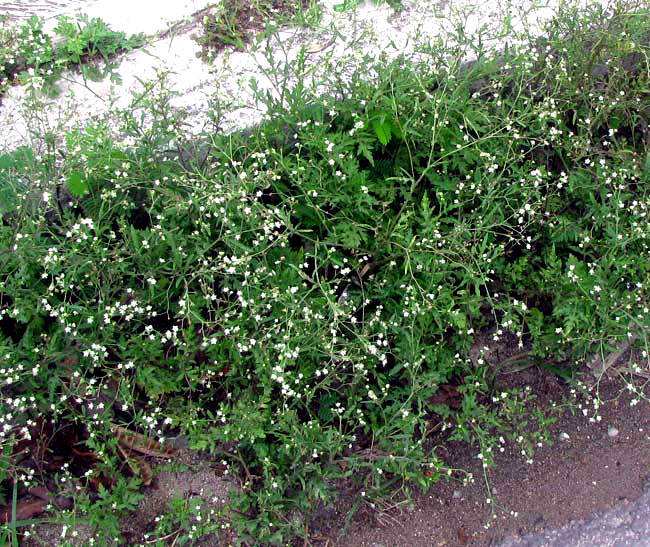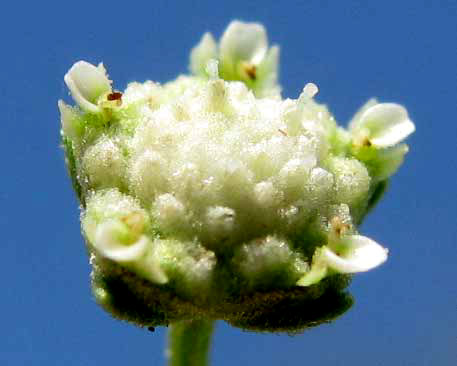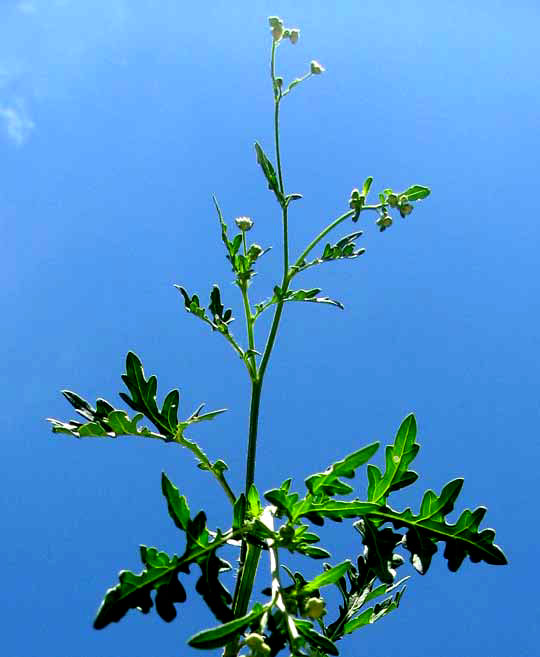Excerpts from Jim Conrad's
Naturalist Newsletter

from the May 30, 2010 Newsletter issued from Hacienda Chichen Resort beside Chichén Itzá Ruins, central Yucatán, MÉXICO; limestone bedrock, elevation ~39m (~128ft), ~N20.676°, ~W88.569°
FEVERFEW
"Parthenium (PARTHENIUM HYSTEROPHORUS) is one of the worst weeds for agriculture, the environment and human health in Queensland, Australia. It is native to Mexico and the USA and has spread prolifically in central Queensland."
Those words were lifted from an Australian website dealing with weeds, and I'm not at all surprised by what's said. For, even here in its native land, wherever the soil is super abused and environmental conditions are most severe, Parthenium hysterophorus is one of a handful of species almost obligatorily occurring. The plant grows at the edge of the much-trampled volleyball court next to the old church, it's along the edge of the Hacienda's entrance road, and the other day when I walked into Pisté to buy fruit a long line of them formed a continuous, raggedy green border growing from the narrow crack between the highway's asphalt and the sidewalk, as shown above.
Members of the genus Parthenium often are referred to as Wild Quinine, and this particular species sometimes is called Feverfew or Santa Maria. Partheniums are members of the Composite or Sunflower Family. Many genera within that vast family are hard to recognize unless you know their technical characters, but Parthenium's tiny flowers are so distinct that they're easy to recognize.
Remember that typical composite flower heads consist of small, cylindrical "disk flowers" stacked side-by-side in the head's center (the "eye" of a sunflower) and flattish "ray flowers," which radiate out from the head's margine as if they were petals. You can review composite flower structure on my page at www.backyardnature.net/fl_comps.htm.
What's unusual about Parthemium flower heads is that they bear only five or so ray flowers (most composite flowers with rays have many more than five), and the rays are so short and stubby. You can see what I mean below:

In that picture the large, bumpy center zone is composed of mostly-not-yet-open disk flowers, which bear both male and female parts but are sterile, and around the head's edge you can see five scooplike ray flowers, which bear only female parts, but are the only flowers that produce fruits.
Several Parthenium species occur in North America. Parthenium hysterophorus differs from all those by having its main leaves divided almost or entirely all the way to their midribs, as shown below:

With common names like Feverfew and Wild Quinine you might guess that Parthenium species may have medicinal value. Maximino Martínez's Las Plantas Medicinales de México warns that 1cc of its juice injected intravenously kills a dove but not a dog, and you shudder to think of how they figured that out. He says that the juice destroys hemoglobin and is an anticoagulant. In Mexico the plant is used traditionally mostly for arthritis, with other uses mentioned such as against neuralgia.